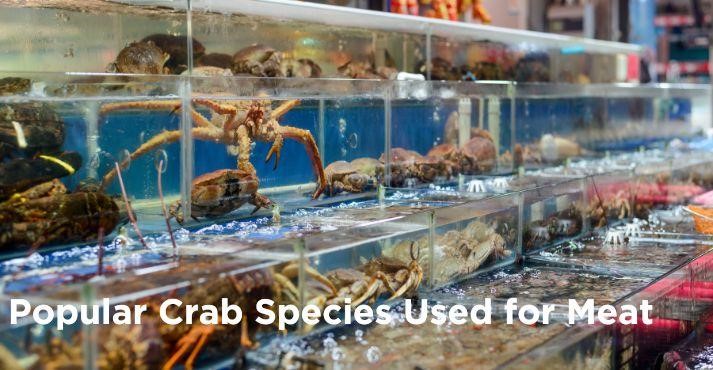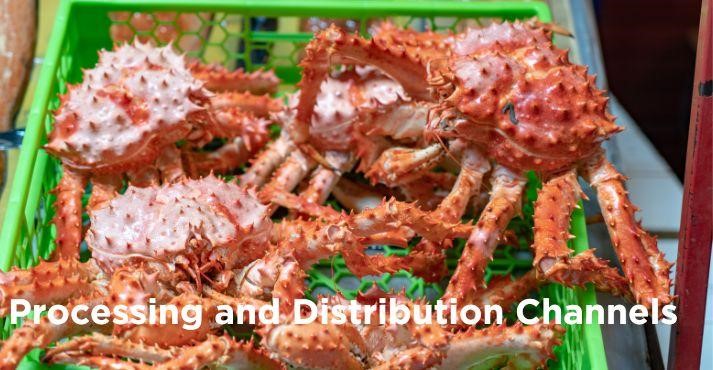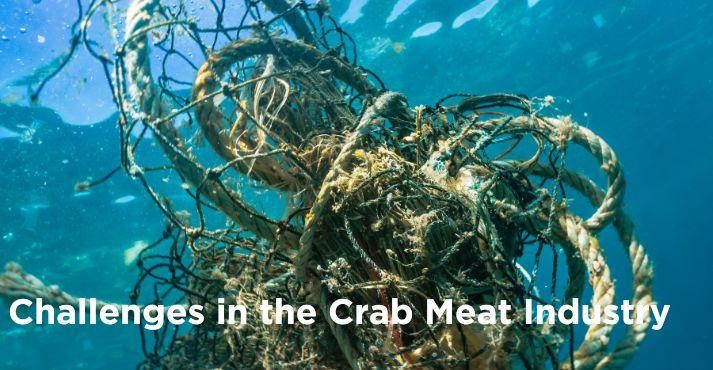Step into the delicious world of crab meat, a seafood favorite that has won hearts around the globe. In our exploration of the 2024 crab meat industry, we’ll look at the story of this culinary delight.
From its humble beginnings to becoming a global sensation, crab meat has delighted taste buds and played a vital role in international cuisine.
Let’s go through this discovery, where we celebrate the simplicity and richness of crab meat, a tasty treasure that connects us all through the shared joy of good food.
Get ready to savor the flavors and discover the global appeal of crab meat!
Current State of the Crab Meat Market
Let us now explore the world crab meat market in 2024, where the numbers and facts reflect the growth and attractiveness of the world market crab.
The market is experiencing an upswing, with a 3.15% increase in crab production globally. Noteworthy contributors in the growing crab meat supply include Canada, boasting a 6.0% surge; Russia, with a 12% uptick; and Norway, where crab production is skyrocketing by an impressive 18.6%.
These numbers reflect the enduring popularity of crab meat in the broader seafood industry.
On the consumer side, there’s a notable 4.7% rise in the global demand for crab meat. This surge is attributed to the growing recognition of crab meat as a healthy choice, rich in protein and low in fat.
As dietary preferences shift towards healthier options, crab meat is a flavorful and nutritious delight.
In tune with environmental consciousness, there’s a commendable 15% increase in adopting sustainable fishing practices within the industry. This underscores a collective commitment to preserving marine ecosystems and recognizing the importance of responsible sourcing.
As we explore the most delectable and popular foods in Asia, the crab meat market emerges as a culinary favorite and a component of the broader seafood industry.
Popular Crab Species Used for Meat

Crab, a culinary gem, offers various flavors and textures across various species. Let’s look at some popular crab varieties that grace dinner tables globally, adding to the esteemed crab value in the food tradeshow scene.
1. Blue Swimmer Crab (Portunus Armatus)
- Taste and Characteristics: Known for its sweet and delicate flavor, the Blue Swimmer Crab boasts tender, succulent meat. Its distinctive blue-hued claws and olive-green carapace make it easily recognizable.
- Regional Preferences: Widely enjoyed in Southeast Asia, Australia, and parts of the Middle East, this crab has become a staple in many regional cuisines and is a leader in the crab meat industry.
2. Dungeness Crab (Metacarcinus Magister)
- Taste and Characteristics: The Dungeness Crab is a West Coast favorite with its sweet, flaky white meat. Its large size and robust taste make it a prized choice for crab lovers.
- Regional Preferences: Particularly cherished along the Pacific Coast of North America, from Alaska to California, where it takes center stage in seafood feasts.
3.Mud Crab (Scylla Serrata)
- Taste and Characteristics: The Mud Crab offers a rich, sweet taste with firm flesh. Its versatility in various culinary preparations, from stir-fries to curries, makes it highly sought after.
- Regional Preferences: Widely harvested in Asia and Australia, it holds a special place in the hearts of seafood enthusiasts across the continent.
4.Snow Crab (Chionoecetes Opilio)
- Taste and Characteristics: Renowned for its delicate, sweet taste and tender texture, the Snow Crab’s clusters of snowy-white meat are a delicacy. Its popularity extends beyond its native northern waters.
- Regional Preferences: Highly favored in North American and European markets, the Snow Crab has become a star in seafood dishes worldwide.
As leading crab producers and crab meat exporters cater to diverse tastes, these varieties contribute significantly to crab export by country, showcasing the global impact of the crab meat industry.
Whether you’re a seafood enthusiast or a food tradeshow attendee, exploring the tones of these crab species promises a flavorful experience through different culinary delights.
Global Crab Meat Production
The dynamics of crab meat production are characterized by regional diversity and varied methods, each playing a significant role in meeting global demands.
1. Asia-Pacific Dominance:
Asia-Pacific emerges as a dominant force, with China, Indonesia, and India leading in production volume, contributing substantially to the frozen food market. Production methods in this region range from traditional artisanal approaches to contemporary aquaculture practices.
2. North America’s Role:
Additionally, North America, particularly the United States and Canada, holds prominence in the global crab meat production scenario, notably for species such as Dungeness and Snow Crab. Production volumes in this region exhibit seasonal variations due to climatic conditions and regulatory measures designed to ensure sustainable harvesting.
3. Environmental Sustainability Concerns:
The crab meat industry is paying more attention to how it affects the environment, and changes are happening. People are adopting better practices, like using special traps and taking steps to protect the places where crabs live.
In dealing with all these changes, the global crab meat industry responds to what people want in the frozen food market and connects with more significant trends in the food and drink business in Asia-Pacific.
The industry is trying to find a good balance – making enough crab for today’s needs while ensuring we’re not harming the oceans and where the crabs call home.
Processing and Distribution Channels

Let’s break down how crab meat goes from the ocean to your plate. The process involves careful steps in the crab meat industry, and technology plays a significant role.
1. Harvesting and Processing:
First, crabs are caught using various methods, like traps. Once caught, they’re taken to processing plants. There, skilled workers carefully extract the meat from the shells. This meat is then cleaned and cooked to make it safe and delicious.
2. Technology at Play:
Modern machines help in this process, making it quicker and more efficient. Technology also ensures that the crab meat stays fresh and safe for you to enjoy. This part is crucial for the canned food market, where the crab meat supply must be consistent and high-quality.
3. Distribution Channels:
After processing, crab meat takes different paths. Some head to local markets, ensuring nearby communities can access this tasty seafood.
Others travel far and wide, becoming exports to different countries. Crab meat exporters play a crucial role in making sure people worldwide get a taste of this delicacy.
Consumer Trends and Preferences
As people’s tastes evolve, so does the world of crab meat. Health is on everyone’s mind, impacting what people want to eat. Many now prefer crab meat because it’s not just tasty but also healthier.
1. Health and Culinary Choices:
Health trends play a significant role, and crab meat fits well into this trend. It’s low in fat and high in protein, aligning with health-conscious choices. Culinary innovations also contribute, with crab meat becoming a star ingredient in diverse, flavorful dishes.
2. Emerging Market Demands:
What people want on their plates changes, and crab meat is gaining more attention. People are looking for high-quality crab meat, and this demand isn’t just local.
It’s a global thing. Crab meat supply needs to meet these changing tastes and preferences, and exporters play a vital role in ensuring everyone can enjoy it.
3. Rise of Frozen Crabs:
The frozen food market is witnessing a surge in demand for convenience, and frozen crabs are at the forefront. People want something quick and easy without compromising taste. This shift in preference is causing the demand for frozen crabs to soar worldwide.
The crab meat industry adapts to meet people’s wants in this changing culinary world.
Challenges in the Crab Meat Industry

The crab meat industry, while thriving, encounters hurdles that need careful attention. Overfishing is one significant challenge. As the demand rises globally, there’s a risk of catching too many crabs, upsetting the balance of their populations.
1. Overfishing Concerns:
Overfishing can lead to a decline in crab populations in the world market, where crab value is high. This not only affects the environment but also jeopardizes the industry’s long-term sustainability.
2. Environmental Impact:
Overfishing isn’t the only concern. It can harm the ecosystems where crabs live. This impact extends beyond the industry itself, affecting marine life and habitats. Preserving these environments is crucial for the future of the crab meat supply.
3. Seeking Solutions:
Efforts are underway to address these challenges. Some involve limiting how many crabs can be caught to prevent overfishing. Others focus on using more sustainable fishing methods, like traps, to reduce environmental impact.
4. Sustainability Initiatives:
Sustainability is becoming a priority. The crab meat industry is working on better practices to ensure a delicate balance. This includes adopting eco-friendly methods, monitoring crab populations, and supporting conservation efforts.
As we explore the challenges faced by the crab meat industry, it’s clear that finding solutions is crucial. Balancing the demands of the world market crab with preserving crab value and ensuring a sustainable crab meat supply requires thoughtful actions.
Innovations in Crab Meat Products
The world of crab meat is evolving, and exciting innovations are shaping the way we experience this culinary delight.
1. New Processing Techniques:
Innovative processing methods are transforming crab meat products. These techniques ensure freshness and quality, meeting the demands of consumers worldwide. Crab meat exporters are crucial in making these innovative products available to different countries.
2. Creative Packaging and Presentations:
Packaging has taken a creative turn, making crab meat products delicious and visually appealing. Unique presentations enhance the overall dining experience, capturing the attention of seafood enthusiasts. It’s not just about the taste; it’s about making crab meat a feast for the eyes, too.
3. Culinary Trends and Unique Recipes:
The culinary world is accepting crab meat in exciting ways. From trendy seafood bowls to fusion recipes that blend flavors, there’s a constant exploration of unique and delicious ways to enjoy crab meat.
This extends beyond borders, with crab export by country introducing diverse cuisines to this versatile ingredient.
The crab meat industry adapts to changing tastes and preferences as we savor these innovations.
Crab Market Key Players

The crab market is like a busy neighborhood, filled with big international companies and local businesses, all trying to win over more customers and cover more ground. This friendly competition is about getting more people to buy their crab products, whether frozen or canned.
This competition is a big deal because it shows companies’ importance in getting crab products to your table. They want to be the ones you choose when looking for delicious crab. Here are the key players :
- Bumble Bee Foods, LLC
- Supreme Crab and Seafood, Inc.
- Maine Lobster Now
- Millennium Ocean Star Corporation
- Phil-Union Frozen Foods, Inc.
These significant companies and others not explicitly mentioned collectively drive the crab meat industry, making significant strides as leading crab producers.
As they engage in the supply and trade of frozen and canned crabs, their collective efforts contribute to the industry’s dynamism and cater to the diverse preferences of consumers.
Crab Meat Industry (FAQs)
What are the leading exporters in the crab meat market?
Key exporters in the crab meat market include major players like Bumble Bee Foods, Supreme Crab & Seafood, Maine Lobster Now, Millennium Ocean Star Corporation, and Phil-Union Frozen Foods.
What is the average export price of crab meat?
The average export price of crab meat varies depending on factors such as the type of crab, processing methods, and market demand. Currently, $15,967 per ton is the ongoing average export price.
What is the average import price of crab meat?
Like export prices, the average import price of crab meat fluctuates based on market conditions and factors like sourcing regions. Currently, $12,979 per ton is the ongoing average import price.
Conclusion
In summary, the crab meat industry is like a bustling marketplace, filled with big and local players, all striving to meet the varied tastes of consumers. Everyone from giants to neighborhood contributors pitches in to provide delicious crab options.
While prices for exporting and importing crab meat may shift, the industry remains dynamic, constantly introducing fresh ideas and strongly emphasizing sustainability. The leading exporters, tackling challenges head-on, play a vital role in steering the path of the crab meat industry.
Their efforts ensure we can continue relishing flavorful and sustainable crab meat, creating a harmonious blend of taste and responsibility for consumers worldwide.





























